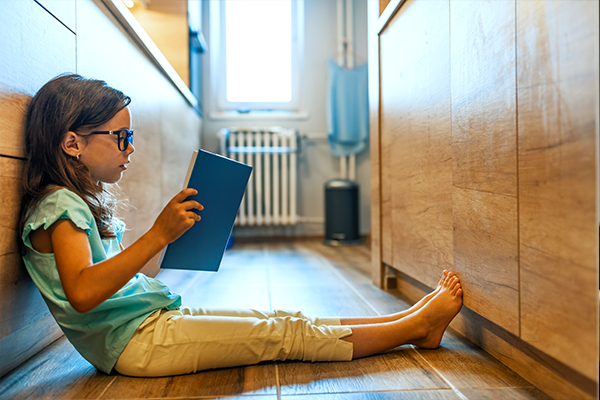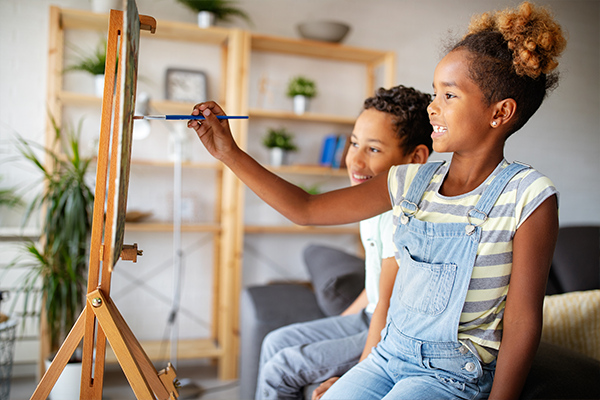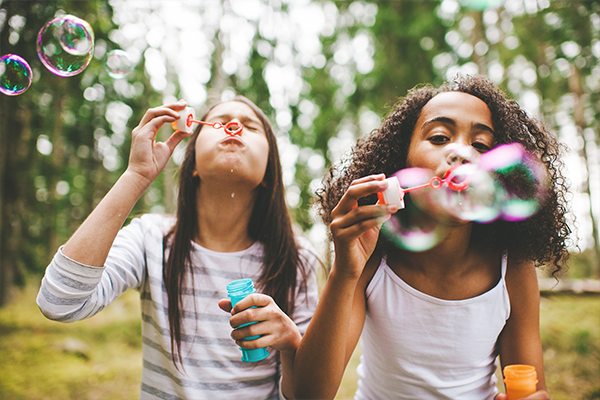Beginning at About Age 3 and Continuing Until About Age 7 Children
As kids grow from grade-schoolers to preteens, you can expect many changes from their physical appearances to their favorite activities. Children between 6 and 12 years old will begin valuing friendships and become more involved in activities like sports and/or painting.
Doctors use certain milestones to tell if a child is developing as expected. There's a wide range of what's considered normal, so some children gain skills earlier or later than others. Children who were born prematurely reach milestones later. Always talk with your doctor about your child's progress.
What can my 6- to 12-year-old child do at this age?
As your child continues to grow, you will notice new and exciting abilities that your child develops. While children may progress at different rates and have diverse interests, the following are some of the common milestones children may reach in this age group:
6- to 7-year-olds:
- Enjoy many activities and stays busy
- Like to paint and draw
- Practice skills in order to become better
- Jump rope
- Ride bikes
- Can tie shoelaces
- Can do simple math like adding and subtracting
8- to 9-year-olds can:
- Jump, skip and chase
- Dress and groom self completely
- Use tools (i.e., hammer, screwdriver)
10- to 12-year-olds may:
- Like to write, draw and paint
What does my 6- to 12-year-old child understand?
As children enter school-age, their abilities and understanding of concepts and the world around them continue to grow. While children may progress at different rates, the following are some of the common milestones children may reach in this age group:
6- to 7-year-olds:
- Understand concept of numbers
- Know daytime and nighttime
- Can differentiate right and left hands
- Can copy complex shapes, such as a diamond
- Can tell time
- Can understand commands with three separate instructions
- Can explain objects and their use
- Can repeat three numbers backwards
- Can read age-appropriate books and/or materials
8- to 9-year-olds:
- Can count backwards
- Know the date
- Read more and enjoy reading
- Understand fractions
- Understand concept of space
- Draw and paint
- Can name months and days of week, in order
- Enjoys collecting objects
10- to 12-year-olds:
- Write stories
- Like to write letters
- Read well
- Enjoy talking on the phone or texting

Wellness and Fitness Milestones
Kids at this age need physical activity to build strength, coordination, and confidence — and to lay the groundwork for a healthy lifestyle. They're also gaining more control over how active they are. Kids who enjoy sports and exercise tend to stay active throughout their lives. Staying fit can improve how kids develop in school, build self-esteem, as well as prevent obesity, and decrease the risk of serious illnesses such as high blood pressure, diabetes and heart disease later in life.
What is "normal" physical growth for a 6- to 12-year-old child?
For 6- to 12-year-olds, there continues to be a wide range of "normal" regarding height, weight and shape. Kids tend to get taller at a steady pace, growing about 2-2.5 inches (6 to 7 centimeters) each year. When it comes to weight, kids gain about 4–7 lbs. (2–3 kg) per year until puberty starts.
This is also a time when kids start to have feelings about how they look and how they're growing. Some girls may worry about being "too big," especially those who are developing early. Boys tend to be sensitive about being too short.
Try to help your child understand that the important thing is not to "look" a certain way, but rather to be healthy. Kids can't change the genes that will determine how tall they will be or when puberty starts. But they can make the most of their potential by developing healthy eating habits and being physically active.
Your doctor will take measurements at regular checkups, then plot your child's results on a standard growth chart to follow over time and compare with other kids the same age and gender.
How can I help my child grow?
Normal growth — supported by good nutrition, enough sleep, and regular exercise — is one of the best overall indicators of a child's good health. Your child's growth pattern is largely determined by genetics.
Pushing kids to eat extra food or get higher amounts of vitamins, minerals, or other nutrients will not increase their height and may lead to weight problems. Accepting kids as they are helps them build self-acceptance. Good mental health is important for healthy development, strong relationships and resilience.

How active should my 6- to 12-year-old be?
School-age kids should have many chances to do a variety of activities, sports, and games that fit their personality, ability, age, and interests. Through physical activities, kids learn about sportsmanship, setting goals, meeting challenges, teamwork, and the value of practice.
Physical activity guidelines for school-age kids recommend that they get at least 1 hour of moderate to strong physical activity daily. In addition:
- Most of the physical activity should be aerobic, where kids use large muscles and continue for a period of time.
- Examples of aerobic activity are running, swimming, and dancing.
- School-age kids usually have brief bouts of moderate to strong physical activity alternating with light activity or rest throughout the day. Any moderate to strong activity counts toward the 60-minute goal.
- Muscle-strengthening and bone-strengthening physical activity should be included at least 3 days a week.
- Children naturally build strong muscles and bones when they run, jump and play. Formal weight programs aren't needed. However, they are safe when properly designed and supervised.
Should my child participate in sports?
Keep in mind your child's age and developmental level, natural abilities, and interests. Kids 6 to 8 years old are sharpening basic physical skills like jumping, throwing, kicking, and catching. Some enjoy doing this in organized sports teams, but non-competitive leagues are best for younger kids. Kids 9 to 12 years old are refining, improving and coordinating skills. Some become even more committed to a sport while others drop out as competition heats up and level of play improves. Regardless of the age or activity, it is important that you show your support by coaching your child's team or cheering from the stands on game days.
It's okay if a child isn't interested in traditional sports, but it's important to find alternative ways to be active. Brainstorm with your kids on activities that feel right for them. Encourage a child who doesn't like soccer, basketball, or other team sports to explore other active options, like karate, fencing, golf, bicycling, skateboarding, and tennis. Most kids won't mind the physical activity as long as they are having fun.
Fitness at Home
Many parents and kids think of organized sports when they think of fitness. Though there are many advantages to signing a child up for a sports team, practice and games once or twice a week will not be enough to reach activity goals. Also, parents shouldn't rely on physical education in schools alone to provide children with enough physical activity.
Here are some ways to keep your child moving at home:
- Make physical activity part of the daily routine. From household chores to an after-dinner walk, keep your family active every day.
- Allow enough time for free play. Kids can burn more calories and have more fun when left to their own devices. Playing tag, riding bikes around the neighborhood, and building snowmen are fun and healthy.
- Keep a variety of games and sports equipment on hand. It doesn't have to be expensive — an assortment of balls, hula-hoops, and jump ropes can keep kids busy for hours.
- Be active together. It'll get you moving, and kids love to play with their parents.
- Limit time spent in sedentary activities such as watching TV, using electronic devices, being online and playing video games.
If you run out of possibilities at home, take advantage of local playgrounds and athletic fields. Make family fitness outings part of your regular routine. Let family members choose an activity — go hiking, ice skating, or try out the rock-climbing gym. Anything goes, as long as everyone can participate. And remember: You'll help show your kids that exercise is important by regularly exercising yourself.
Preventing Sports-Related Injury
Kids who participate in sports are at risk for injuries, so be sure your child wears the proper protective equipment, such as shin-guards and cleats in soccer, or a helmet and protective pads when rollerblading or skateboarding. Kids who specialize in one sport are also at risk of overuse injuries, including stress fractures and joint injuries. If a child is in pain, it is best to rest and let the injury heal before returning to play.
A child with a chronic health condition or disability should not be excluded from these fitness activities in fear of getting a sports-related injury. Some activities may need to be changed or adapted, and some may be too risky depending on the condition. The best thing to do is to talk to your doctor about which activities are safe for your child.
If your child complains of pain during or after physical activity, talk with your doctor.
How long should my 6- to 12-year-old sleep?
School-age kids need 9-12 hours of sleep at night. Bedtime problems can start at this age for a variety of reasons. Homework, sports, after-school activities, screen time, and hectic family schedules all can contribute to kids not getting the sleep they need. Sleep-deprived kids can become hyper or irritable and may have a hard time paying attention in school.
It's still important to have a consistent bedtime, especially on school nights. Leave enough technology-free time before bed to allow your child to unwind before lights-out. Consider switching off the electronics at least an hour before bed. Avoiding keeping a TV in their bedroom.
Check out our Healthy Sleep Guide for Children for more info.
Puberty
Puberty — or sexual development — is a time of dramatic change for both boys and girls. The age at which the physical changes of puberty normally begin varies widely.
For both sexes, these hormone-driven changes are accompanied by growth spurts that transform children into physically mature teens as their bodies develop. They may also experience side effects from these hormones like acne and mood changes.
Puberty in Girls
Breast development, usually the first noticeable sign of puberty in girls, may begin anytime between ages 8 and 13. Events in girls as they go through puberty:
- Breasts begin to develop, and hips become rounded.
- The increase in the rate of growth in height begins.
- Pubic hair begins to appear, usually 6–12 months after the start of breast development. About 15% of girls will develop pubic hair before breast development starts.
- The uterus and vagina, as well as labia and clitoris, increase in size.
- Pubic hair is well established, and breasts grow further. Each breast can grow at different rates, may not be the same sizes.
- The rate of growth in height reaches its peak by about 2 years after puberty began. The average age is 12 years.
- Menstruation begins about 2 years after breast start to develop and almost always after the peak growth rate in height has been reached. The average age is 12.5 years.
- Once girls get their periods, they usually grow about 1 or 2 more inches (2.5 to 5 centimeters), reaching their final adult height by about age 14 or 15 years. Girls can experience this at a younger or older age depending on when puberty began.
Puberty in Boys
Most boys show the first physical changes of puberty between ages 10 and 16 and tend to grow most quickly between ages 12 and 15. The growth spurt of boys is, on average, about 2 years later than that of girls. By age 16, most boys have stopped growing, but their muscles will continue to develop.
Other features of puberty in boys include:
- The penis and testicles increase in size. Testicles can grow at different rates, may not be the same sizes.
- Pubic hair appears, followed by underarm and facial hair.
- The voice deepens and may sometimes crack or break.
- The Adam's apple, or larynx cartilage, gets bigger.
- Testicles begin to produce sperm.
Communication Milestones
How does my 6- to 12-year-old child interact with others?
A very important part of growing up is the ability to interact and socialize with others. During the school-age years, parents will see a transition in their child as he or she moves from playing alone to having multiple friends and social groups. While friendships become more important, the child is still fond of his or her parents and likes being part of a family. While every child is unique and will develop different personalities, the following are some of the common behavioral traits that may be present in your child:
6- to 7-year-olds:
- Cooperate and share
- Can get jealous of others and siblings
- Like to copy adults
- Like to play alone, but friends are becoming important
- Play with friends of the same gender
- May have occasional temper tantrums
- May be modest about body
- Like to play board games
8- to 9-year-olds:
- Like competition and games
- Start to mix friends and play with children of different gender
- May be modest about body
- Enjoy clubs and groups, such as Boy Scouts or Girl Scouts
- May become curious about relationships, but does not admit it
10- to 12-year-olds:
- Will value friendship; may have a best friend
- May develop romantic interests
- Like and respect parents
- Enjoy talking to others
How can I help increase my 6- to 12-year-old child's social ability?
Consider the following as ways to foster your school-aged child's social abilities:
- Set and provide appropriate limits, guidelines and expectations and consistently enforce using appropriate consequences.
- Model appropriate behavior.
- Offer compliments for your child being cooperative and for any personal achievements.
- Help your child choose activities that are appropriate for your child's abilities.
- Encourage your child to talk with you and be open with his or her feelings.
- Encourage your child to read and read with your child.
- Encourage your child to get involved with hobbies and other activities.
- Encourage physical activity.
- Encourage self-discipline; expect your child to follow rules that are set.
- Teach your child to respect and listen to authority figures.
- Teach your child to be aware of consequences of their behavior and empathy for others.
- Encourage your child to talk about peer pressure and help set guidelines to deal with peer pressure.
- Spend uninterrupted time together – giving full attention to your child. A strong, loving relationship can have a direct positive influence on your child's mental health.
- Encourage time outside.
- Limit television, video game and computer time.
Reviewed by Dr. Lydia Villa, Clinica CHOC Para Niños, CHOC Primary Care – May 2021
Source: https://www.choc.org/primary-care/ages-stages/6-to-12-years/

0 Response to "Beginning at About Age 3 and Continuing Until About Age 7 Children"
Postar um comentário